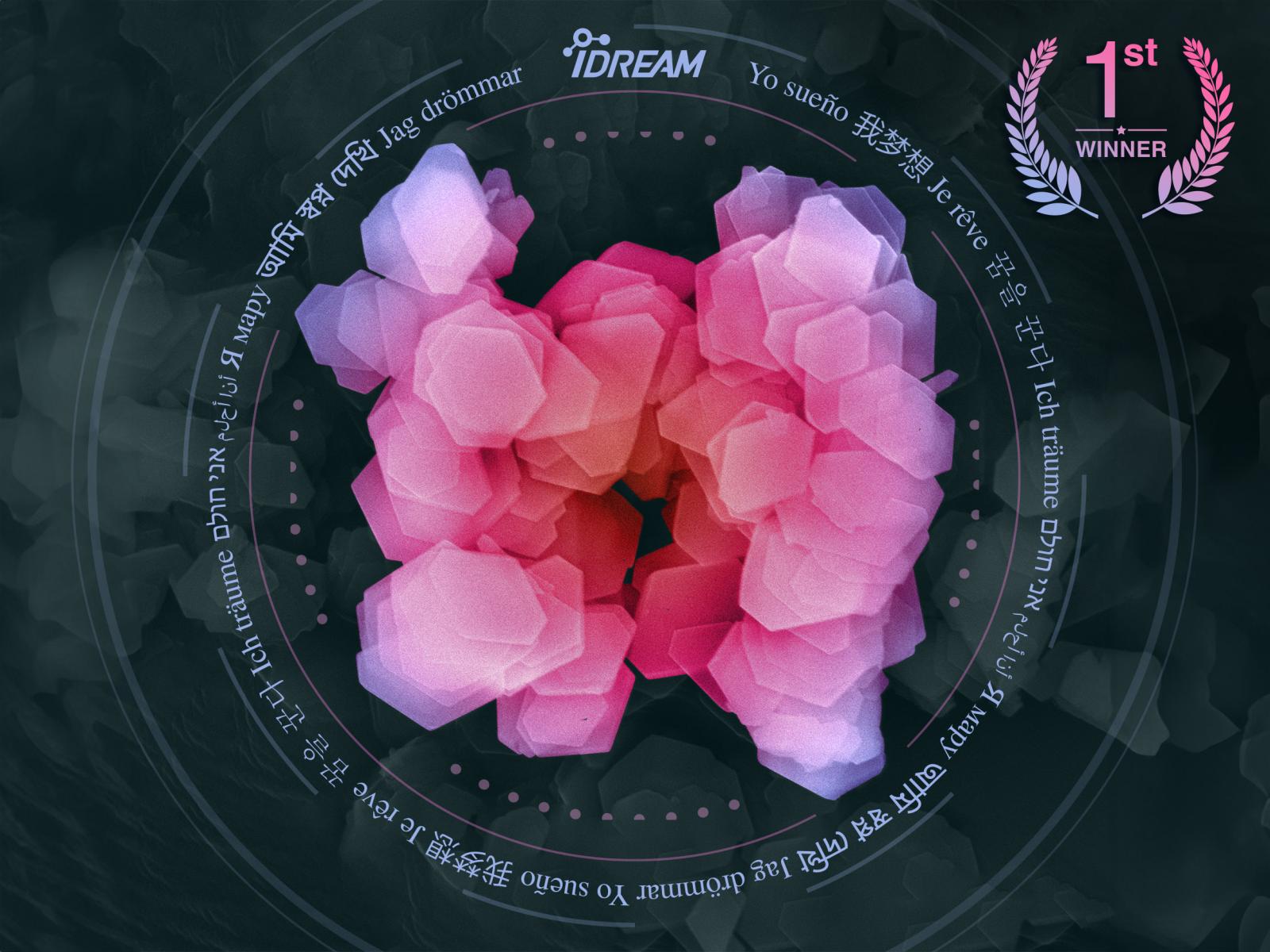IDREAM Poem Takes First Place in DOE Poetry of Science Art Contest

Aluminum crystals found in radioactive Hanford tank waste (in pink) are encircled by the phrase “I dream” in languages inclusive of the native languages spoken by Interfacial Dynamics in Radioactive Environments and Materials (IDREAM) Energy Frontier Research Center team members. The illustration is part of the IDREAM poem—“Can a Scientist Dream it Alone?”—that received the first place award from the judges in the Department of Energy’s Office of Science 2023 Poetry of Science Art Contest.
(Composite image by Nathan Johnson | Pacific Northwest National Laboratory)
A poem inspired by radioactive tank waste—“Can a Scientist Dream it Alone?”—describes how it takes a diverse team of researchers to solve one of the nation’s most complex chemical challenges.
The Interfacial Dynamics in Radioactive Environments and Materials (IDREAM) Energy Frontier Research Center (EFRC) authored the poem about the quest to unravel and understand the chemical phenomena of the Hanford Site’s nuclear waste, which was generated by plutonium production from World War II through the Cold War.
Judges awarded the poem first place in the Department of Energy’s (DOE’s) Poetry of Science Art Contest.
“For the panel of judges to select our poem as first place is huge for IDREAM,” said Carolyn Pearce, IDREAM director. “We really went into this with the spirit of the competition and the goal of getting the team together to produce something that resonates with a broader audience. We wanted to showcase our amazing early career scientists and the diversity of voices contributing to IDREAM science working on a huge and complex problem.”
Sponsored by the DOE Office of Science’s Basic Energy Sciences program, the poetry contest aimed to educate, inspire, and entertain audiences about the extraordinary science, innovation, and people in DOE’s Energy Frontier Research Centers (EFRCs), Energy Innovation Hubs, and Computational Materials and Chemical Sciences (CMS-CSS) programs. Each program is a multi-institutional partnership with a specific research mission. Led by Pacific Northwest National Laboratory, IDREAM is made up of radiation chemists, geochemists, physicists, computational chemists, material scientists, and chemical engineers working together to understand the chemical phenomena of the hazardous tank waste to solve processing issues, in particular at the Hanford Site.
The poetry contest announcement was made at the 2023 EFRC-Hub-CMS-CCS Principal Investigators’ Meeting. More than 500 stakeholders in virtual attendance listened to the poem’s science message as shared by the diverse scientists contributing to IDREAM’s mission.
Robert (Greg) Felsted, the IDREAM Early Career Network representative, accepted the award. “We wanted to represent our work and our people,” he said. “It’s not a poem any one person can read unless you speak a dozen languages.” The team members’ native languages woven through the poem and on the corresponding image are English, Spanish, French, German, Mandarin Chinese, Korean, Hebrew, Bengali, Arabic, Belarusian, and Swedish.
DOE’s judges—chosen for their science communications expertise—selected the overall winners, recognizing poems for their ability to communicate scientific expertise, style, scientific inspiration, originality, creativity, and overall presentation.
Judge Katie McKissick is an author and long-time science communicator. She is the author and illustrator of Beatrice the Biologist, a science blog and webcomic, as well as the digital engagement manager for The Kavli Foundation. Judge David L. Hu is a poet, science communicator, and a professor of mechanical engineering at Georgia Tech. He is the author of How to Walk on Water and Climb Up Walls, which explores the biomechanics that underpin animal locomotion through a combination of biology, engineering, physics, and robotics.
“Judging the contest was a pleasure and an honor,” McKissick said. “Everyone submitted thoughtful and beautiful entries.
“I was impressed by the IDREAM poem, in how it used its acronym as a springboard to express the importance of collaboration and diversity in science,” McKissick said. “At its best, science communication not only shares research with the public, but also allows scientists to see their own work in a new way. I got the sense that that happened here with this poem and imagery.”
“Can a Scientist Dream it Alone?” was a runner up for the People’s Choice Award, having received 507 votes from the public, symbolic of the ability of poetry to spark interest in science. The People’s Choice Award was clinched by The Quantum Materials for Energy-Efficient Neuromorphic Computing (Q-MEEN-C) team from the University of California for their poem “A Quest Profound,” which received 522 votes from the public.
Published: September 26, 2023